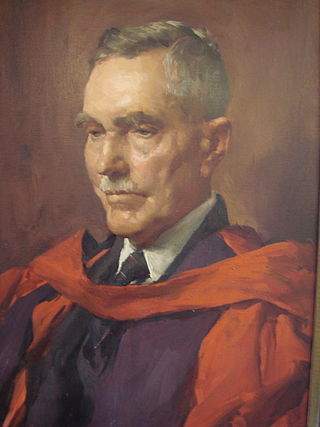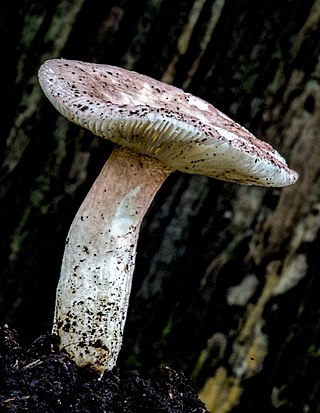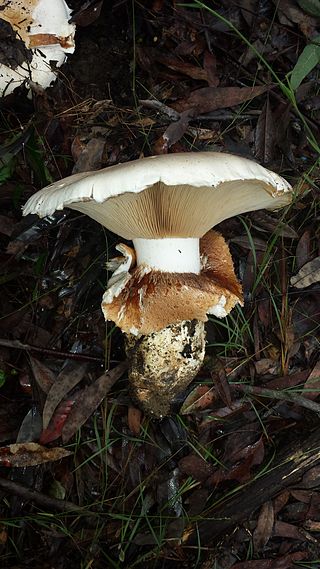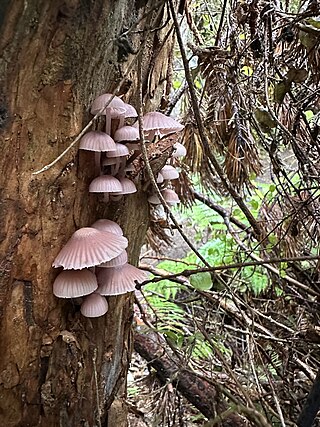
Sir John Burton Cleland CBE was a renowned Australian naturalist, microbiologist, mycologist and ornithologist. He was Professor of Pathology at the University of Adelaide and was consulted on high-level police inquiries, such as the famous Taman Shud Case in 1948 and later. He also studied the transmission of dengue virus by the mosquito Stegomyia fasciata.

The Fungi of Australia form an enormous and phenomenally diverse group, a huge range of freshwater, marine and terrestrial habitats with many ecological roles, for example as saprobes, parasites and mutualistic symbionts of algae, animals and plants, and as agents of biodeterioration. Where plants produce, and animals consume, the fungi recycle, and as such they ensure the sustainability of ecosystems.

Psilocybe subaeruginosa is a species of agaric fungus in the family Hymenogastraceae described in 1927 and known from Australia and New Zealand. As a blueing member of the genus Psilocybe it contains the psychoactive compounds psilocin and psilocybin.

Russula delica is a mushroom that goes by the common name of milk-white brittlegill, and is a member of the genus Russula, all of which are collectively known as brittlegills. It is mostly white, with ochraceous or brownish cap markings, and a short robust stem. It is edible, but poor in taste, and grows in coniferous, broadleaved, or mixed woods. It can be confused with other white Russula species and certain white Lactarius species.

Macrolepiota clelandii, commonly known as the slender parasol or graceful parasol, is a species of mushroom-forming fungus in the family Agaricaceae. The species is found in Australia and New Zealand, where it fruits singly or in small groups on the ground in eucalypt woodlands, parks, and roadsides. It is a tall mushroom up to roughly 20 cm (8 in), with a broad cap covered with distinctive rings of dark brown scales. The whitish gills on the cap underside are closely spaced and free from attachment to the slender stipe, which has a loose ring on its upper half, and a bulbous base. The edibility of the mushroom is not known with certainty, but closely related parasol mushrooms are edible and some are very sought after.

Mycena austrofilopes is a species of mushroom in the family Mycenaceae. It has been found growing in leaf litter under Eucalyptus trees in Victoria, Australia.

Mycena maculata, commonly known as the reddish-spotted Mycena, is a species of fungus in the family Mycenaceae. The fruit bodies, or mushrooms, have conic to bell-shaped to convex caps that are initially dark brown but fade to brownish-gray when young, reaching diameters of up to 4 cm. They are typically wrinkled or somewhat grooved, and have reddish-brown spots in age, or after being cut or bruised. The whitish to pale gray gills also become spotted reddish-brown as they mature. The stem, up to 8 cm (3 in) long and covered with whitish hairs at its base, can also develop reddish stains. The mycelium of M. maculata has bioluminescent properties. The saprobic fungus is found in Europe and North America, where it grows in groups or clusters on the rotting wood of both hardwoods and conifers. The edibility of the fungus is unknown. Although the species is known for, and named after its propensity to stain reddish, occasionally these stains do not appear, making it virtually indistinguishable from M. galericulata.

Pholiota communis is a species of fungus in the family Strophariaceae. It is found in Southeastern Australia. The small brown mushrooms appear in leaf litter of pines and eucalypts in autumn and winter.

Boletus barragensis is a species of bolete fungus in the family Boletaceae native to Australia. It was first reported as form of Boletus luridus in 1934 by John Burton Cleland, before being described by Cheryl Grgurinovic in 1997.
Hygrocybe kula is a mushroom of the waxcap genus Hygrocybe found only in Royal National Park and Lane Cove Bushland Park. It was described in 1997 by mycologist Cheryl Grgurinovic.
Melanoleuca abutyracea is a species of fungus in the family Pluteaceae. Found in Australia, it was first described scientifically in 1931 by John Burton Cleland as a species of Collybia. Mycologist Cheryl Grgurinovic transferred it to Melanoleuca in 2002.

Russula lenkunya is a mushroom in the genus Russula. Found in South Australia, it was first described scientifically by mycologist Cheryl Grgurinovic in 1997.

Panellus pusillus is a species of fungus in the family Mycenaceae. A widely distributed species, it has been recorded in Australia, Asia, Europe, North America, and South America.

Entoloma moongum is a South Australian species of fungus in the large agaric genus Entoloma. It was described as new to science by mycologist Cheryl Grgurinovic; the original holotype collections were made from Belair National Park in the 1930s by John Burton Cleland, who erroneously referred the fungus to Leptonia lampropus.

Austrocortinarius australiensis, commonly known as the skirt webcap, is a species of mushroom in the family Cortinariaceae which is native to Australia and New Zealand. The white mushrooms appear in autumn and can grow very large, with their caps reaching 30 cm (12 in) in diameter.
Hygrophoropsis psammophila is a species of fungus in the family Hygrophoropsidaceae. Originally described by John Burton Cleland in 1933 as Paxillus psammophilus, it was transferred to the genus Hygrophoropsis by Cheryl Grgurinovic in 1997. It is found in Australia, where it grows in groups in sand.

Cortinarius sublargus is a species of fungus in the family Cortinariaceae native to Australia. It was described in 1928 by John Burton Cleland from the Mount Lofty Ranges. Cleland also described Cortinarius radicatus in 1933 from material collected in Willunga Hill, Waitpinga, Mount Lofty, Mount Compass, and Kinchina, Though Cleland regarded them as distinct, later authorities determined them to be the same species. The latter name turned out to be a homonym, having already been given to a different species.

Mycena albidocapillaris is a species of mushroom in the family Mycenaceae that is found in Australia. It was first described scientifically in 1933 by mycologist John Burton Cleland, who named it Mycena subcapillaris. The type collection was made in 1922 on Mount Lofty. It was later discovered that the name was invalid, as Paul Hennings use of that name in 1899 took precedence. Cheryl Grgurinovic and Tom May republished the species with the new replacement name Mycena albidocapillaris in 1997.

Lichenomphalia chromacea is a species of basidiolichen in the family Hygrophoraceae. It is found in southern Australia. The yellow-orange fruiting bodies of the species are mushroom-like, with a cap width of typically less than 4 cm. The thallus of the lichen is a greenish, granular layer of fungal hyphae and algae on the soil around the base of the stipe.

Mycena clarkeana is a species of bonnet fungus in the genus Mycena. Originally endemic to Australia, it can now be found in New Zealand also.

















